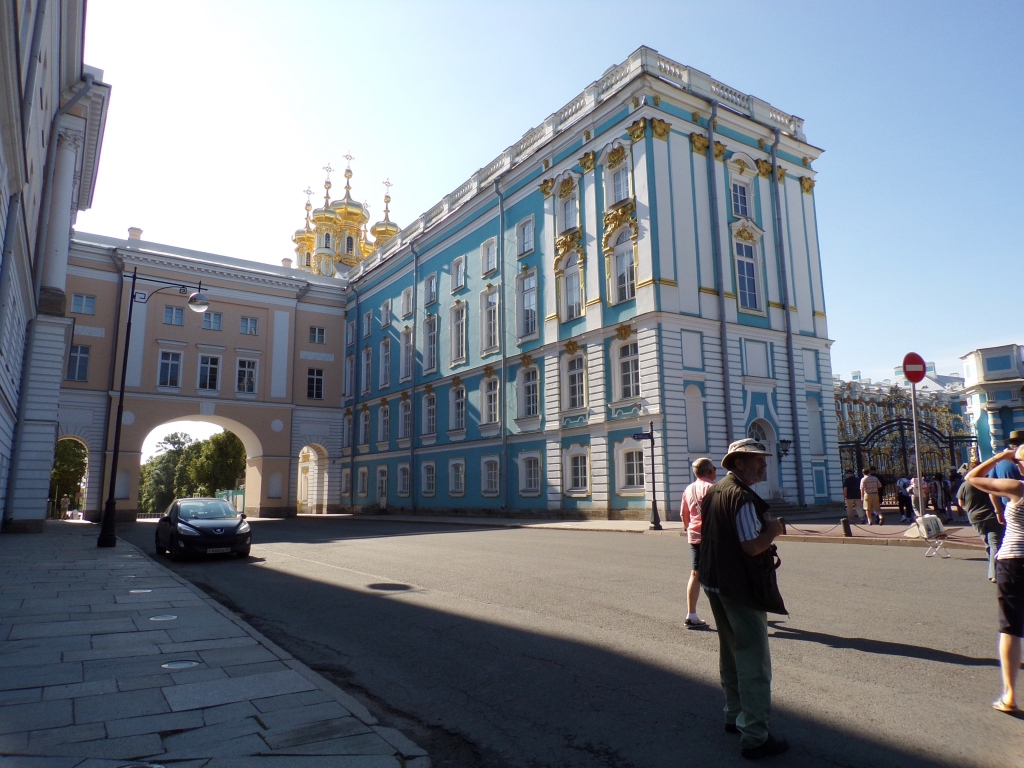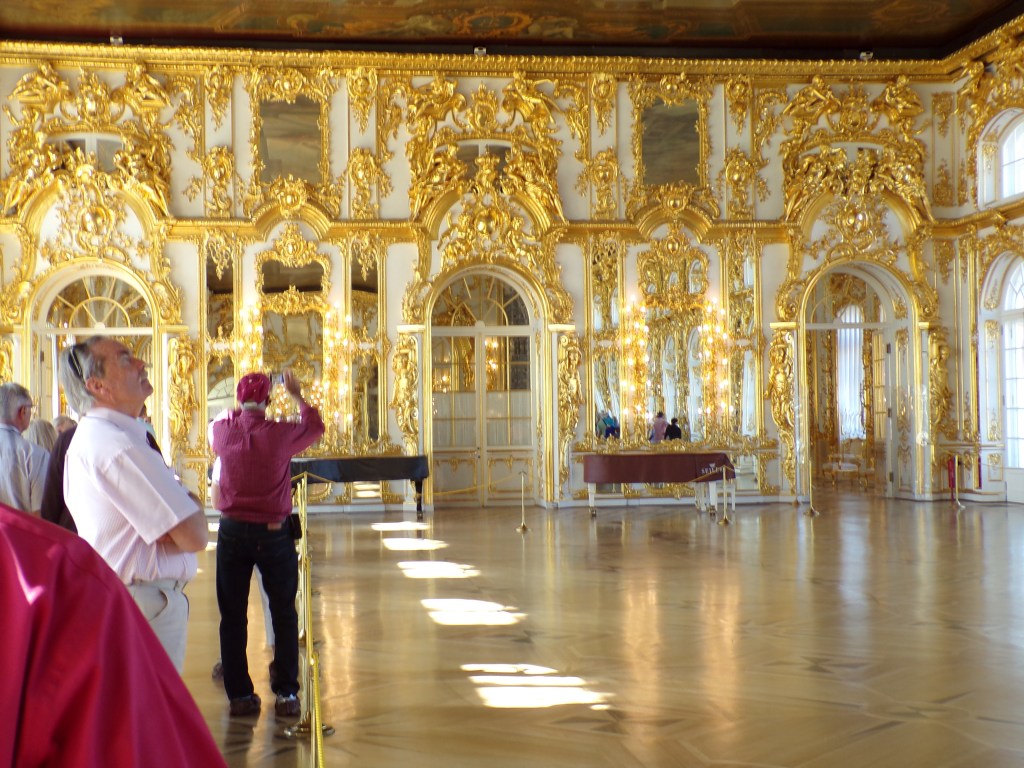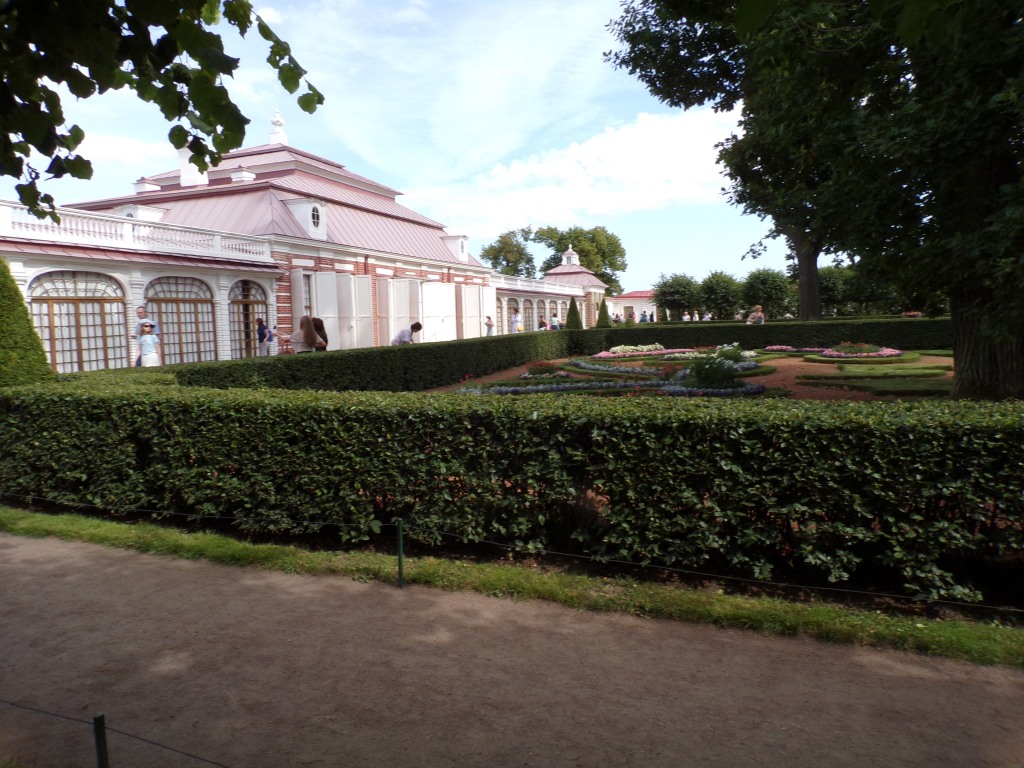August 11-12, 2015
Catherine’s Palace
It’s no wonder there was a revolution in Russia, I couldn’t help thinking when we toured the opulent and ostentatious Catherine’s Palace. Some of it was beautiful; some of it was garish. All of it was obviously extremely expensive.
Catherine’s Palace was a gift from Peter the Great to his wife, Catherine I. The first palace on this site, referred to as the “small palace”, was built in the 1720s but was enlarged in the mid-18th century by another architect commissioned by the queen. The resulting palace contains both Baroque and Classical elements.
 Catherine’s Palace was a favorite of the last tsar, Nicholas, and his family. The day before, I had visited another Catherine’s Palace outside Tallinn, Estonia (see my post Touring Tallinn …), also a gift from Peter the Great to his 2nd wife, but much smaller and less luxurious.
Catherine’s Palace was a favorite of the last tsar, Nicholas, and his family. The day before, I had visited another Catherine’s Palace outside Tallinn, Estonia (see my post Touring Tallinn …), also a gift from Peter the Great to his 2nd wife, but much smaller and less luxurious.
Peter been married before but was not in love, so when he met Catherine, he dispatched his first wife to a convent! Women were submissive and had few rights in those days, so I suppose she had to obey. Catherine came from a peasant family and in a Cinderella-type story, they fell in love and were married. Peter & Catherine had several children but most died in childhood. Elizabeth was one of two surviving children, and she took the throne in 1741. Her daughter-in-law was Catherine the Great.
After a long wait to get in, and then donning slippers over our shoes to protect the floors, our tour group went through room after room of Baroque style gold-leaf decorations.
 Since this palace belonged to Peter the Great’s beloved second wife, her monogram would be included on some of the decorations, which looked like a 3 with a vertical line through it. The “3” is the y sound, which is how Catherine is spelled and pronounced in Russian: “Yeh-Katerina.”
Since this palace belonged to Peter the Great’s beloved second wife, her monogram would be included on some of the decorations, which looked like a 3 with a vertical line through it. The “3” is the y sound, which is how Catherine is spelled and pronounced in Russian: “Yeh-Katerina.”
Fireplaces of blue tile in each room are beautiful contrasts to all the gold.

Formal dining room – the paintings on the wall depict animals having killed and are preparing to eat their prey. These gruesome images were supposed to increase the diners’ appetites!
After the Russian Revolution of 1917, the palace and grounds were turned into a museum, while other buildings in “Tsars’ Village”, as the town surrounding Catherine’s Palace was known, were turned into educational and health facilities for children. The Bolsheviks thus renamed the town “Children’s Village.” In 1937, the country commemorated the 100th anniversary of the death of the poet Pushkin, and the village was once again renamed; the town of “Pushkin” is still called by this name today.
The furnishings are mostly replicas, because the palace was used as Nazi headquarters during WWII, and when they left, they destroyed it. Restoration was done with the aim to recreate the palace interior as much as possible to its original design. Someone on our ship joked that if you want job security in Russia, get a job in restoration!

This painting depicts how the palace looked after the Nazis left, having set the interior on fire. The outer walls are standing, but the interior was mostly destroyed.
Most of the rooms are designed in Baroque style, but when the palace was expanded in the mid-18th century by another architect commissioned by Empress Elizabeth, it was done in Classical style.
Our guide, Katrina, gave a running commentary on the walls, columns, floors, décor, paintings, furnishings, dishes, etc. as we passed along; as usual when I visit palaces, all the luxury in room after room eventually overwhelms me and I stop really paying attention; the fact that the audio equipment didn’t work very well didn’t help.
 However, like at other palaces I’ve visited, there is always at least one room that really stands out while all the other rooms blend together in a blur. In this case, the room that made an impression on me was the Amber Room, which is showcased in books about the palace, since no photography is permitted, unlike the rest of the palace. It really is quite spectacular. The walls, moldings and furnishings are all made of amber.
However, like at other palaces I’ve visited, there is always at least one room that really stands out while all the other rooms blend together in a blur. In this case, the room that made an impression on me was the Amber Room, which is showcased in books about the palace, since no photography is permitted, unlike the rest of the palace. It really is quite spectacular. The walls, moldings and furnishings are all made of amber.
 The light colored amber – usually the most desired – is the oldest; the darkest is the youngest. The variety of colors is quite amazing. Pieces of different color amber were fitted together mosaic style to form the layers on the walls, etc. There’s also a table whose top is a mosaic of different colored amber.
The light colored amber – usually the most desired – is the oldest; the darkest is the youngest. The variety of colors is quite amazing. Pieces of different color amber were fitted together mosaic style to form the layers on the walls, etc. There’s also a table whose top is a mosaic of different colored amber.


 Note: All pictures of the Amber Room were downloaded from Google Images.
Note: All pictures of the Amber Room were downloaded from Google Images.
One of the last rooms we visited was in Classical style – the walls were green and the white wall décor had more angular lines and more secularized themes. Although sumptuously decorated also, it didn’t have gold cherubs, statues, moldings, etc. which are the hallmarks of Baroque ornamentation.
 The gardens outside were mostly sculpted and symmetrical in design.
The gardens outside were mostly sculpted and symmetrical in design.
~~~~~
Peterhof
Peterhof is not just one palace – it is an estate containing a large park with fountains, gardens, and other buildings. The Grand Palace is what you first see when you arrive by car or bus. Like other Russian palaces, it is huge and is often referred to as the “Russian Versailles”. Versailles was the inspiration for Peter the Great’s desire to build an estate outside the new city of St. Petersburg.
The first palace built on the grounds was “Monplaisir”, a much smaller structure, designed by and for Peter himself, situated on the Gulf of Finland. It is what you see when you arrive or depart from the pier. Marly Palace (a much smaller Baroque mansion on the grounds, meant to be an intimate retreat) and another two-story building on a nearby island, to be used as a dining room, were also built before the grand palace.
Landscaping of the grounds had begun by the early 1720s, but work on the site stopped when Peter the Great died in 1725 and Peterhof was left abandoned until Peter’s daughter Elizabeth took the throne in 1740. Elizabeth commissioned Bartolomeo Rastrelli, who had already completed the Summer Palace in St. Petersburg, to build an opulent royal palace. The completed palace is long and narrow and not as ornate as Catherine’s Palace. We did not go inside, which was okay with me, but instead had time to explore the grounds.





 Fountains were an integral part of the plan conceived by Peter for this estate, and each succeeding generation outdid the previous one by adding more sumptuous and ingenious fountains throughout the grounds. The Grand Cascade, in front of the grand palace, is composed of 64 fountains and over 200 bronze statues and other decorations. At the center is a statue of Samson wrestling with a lion.
Fountains were an integral part of the plan conceived by Peter for this estate, and each succeeding generation outdid the previous one by adding more sumptuous and ingenious fountains throughout the grounds. The Grand Cascade, in front of the grand palace, is composed of 64 fountains and over 200 bronze statues and other decorations. At the center is a statue of Samson wrestling with a lion.
There are also unusual fountains such as the Chess Cascade and the Joke Fountains – here’s where the children have fun. One of these sprays water on a person who steps on a particular stone. Another is like a water fall that starts and stops, which you can stand under.

One of the “Joke” fountains – you don’t know when the water will start or stop. The children love it!
The gardens were absolutely beautiful. Catherine the Great oversaw the first landscaped garden at Peterhof, the English Park. Everywhere we walked were more fountains, more gardens, but none of them the same.

 Being on our own by this time, my husband and I took a route through a small part of the park, but by no means did we see all of it – in one afternoon, that would have been impossible.
Being on our own by this time, my husband and I took a route through a small part of the park, but by no means did we see all of it – in one afternoon, that would have been impossible.

This rocky beach on the edge of the Peterhof estate borders the Gulf of Finland. The small yellow building on an outcrop of land in the distance was meant for use as a dining room for entertaining guests.
 We met the others in our group at the hydrofoil dock, and took a hydrofoil back to St. Petersburg.
We met the others in our group at the hydrofoil dock, and took a hydrofoil back to St. Petersburg.




















